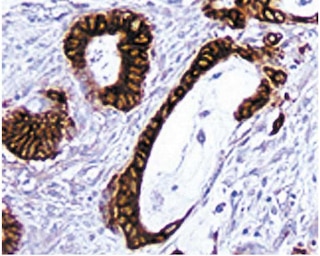Old Browser
This page has been recently translated and is available in French now.
Looks like you're visiting us from {countryName}.
Would you like to stay on the current country site or be switched to your country?




Immunohistochemical staining of T lymphocytes. Frozen sections of normal human tonsil was reacted with the CD3 antibody. T lymphocytes can be identified by the intense brown labeling of their cell membranes. Amplification 20X.


BD Pharmingen™ Purified Mouse Anti-Human CD3

Regulatory Status Legend
Any use of products other than the permitted use without the express written authorization of Becton, Dickinson and Company is strictly prohibited.
Preparation And Storage
Recommended Assay Procedures
Immunohistochemistry: The clone HIT3a specific for human CD3 is recommended to test for immunohistochemical staining of acetone-fixed frozen sections. Tissues tested were human spleen and tonsil. The antibody stains peripheral T lymphocytes and some thymocytes. The isotype control recommended for use with this antibody is purified mouse IgG2a (Cat. No. 550339). For optimal indirect immunohistochemical staining, the HIT3a antibody should be titrated (1:10 to 1:50 dilution) and visualized via a three-step staining procedure in combination with biotin anti-mouse IgG2a (Cat. No. 550332) as the secondary antibody and Streptavidin-HRP (Cat. No. 550946) together with the DAB detection system (Cat. No. 550880). A detailed protocol of the immunohistochemical procedure is available on our website at www.bdbiosciences.com/pharmingen/protocols. The clone HIT3a is not recommended for formalin-fixed paraffin embedded sections.
Product Notices
- Since applications vary, each investigator should titrate the reagent to obtain optimal results.
- Caution: Sodium azide yields highly toxic hydrazoic acid under acidic conditions. Dilute azide compounds in running water before discarding to avoid accumulation of potentially explosive deposits in plumbing.
- Source of all serum proteins is from USDA inspected abattoirs located in the United States.
- An isotype control should be used at the same concentration as the antibody of interest.
- This antibody has been developed for the immunohistochemistry application. However, a routine immunohistochemistry test is not performed on every lot. Researchers are encouraged to titrate the reagent for optimal performance.
- Please refer to www.bdbiosciences.com/us/s/resources for technical protocols.
Companion Products





The HIT3a monoclonal antibody specifically binds to the human CD3ε-chain, a 20 kDa subunit of the CD3/T cell antigen receptor complex found on 70-80% of normal human peripheral blood lymphocytes and 60-85% of thymocytes. Studies from the HLDA Workshop show that this antibody can be mitogenic for T lymphocytes. The CD3 complex plays a role in signal transduction during antigen recognition by the T cell receptor. HIT3a antibody does not stain intracellular CD3 unlike the other CD3-specific clone, UCHT1 (Cat. No. 555330/550368).
Development References (4)
-
Beverley PC, Callard RE. Distinctive functional characteristics of human "T" lymphocytes defined by E rosetting or a monoclonal anti-T cell antibody. Eur J Immunol. 1981; 11(4):329-334. (Biology). View Reference
-
Knapp W. W. Knapp .. et al., ed. Leucocyte typing IV : white cell differentiation antigens. Oxford New York: Oxford University Press; 1989:1-1182.
-
McMichael AJ. A.J. McMichael .. et al., ed. Leucocyte typing III : white cell differentiation antigens. Oxford New York: Oxford University Press; 1987:1-1050.
-
Schlossman SF. Stuart F. Schlossman .. et al., ed. Leucocyte typing V : white cell differentiation antigens : proceedings of the fifth international workshop and conference held in Boston, USA, 3-7 November, 1993. Oxford: Oxford University Press; 1995.
Please refer to Support Documents for Quality Certificates
Global - Refer to manufacturer's instructions for use and related User Manuals and Technical data sheets before using this products as described
Comparisons, where applicable, are made against older BD Technology, manual methods or are general performance claims. Comparisons are not made against non-BD technologies, unless otherwise noted.
For Research Use Only. Not for use in diagnostic or therapeutic procedures.
Report a Site Issue
This form is intended to help us improve our website experience. For other support, please visit our Contact Us page.